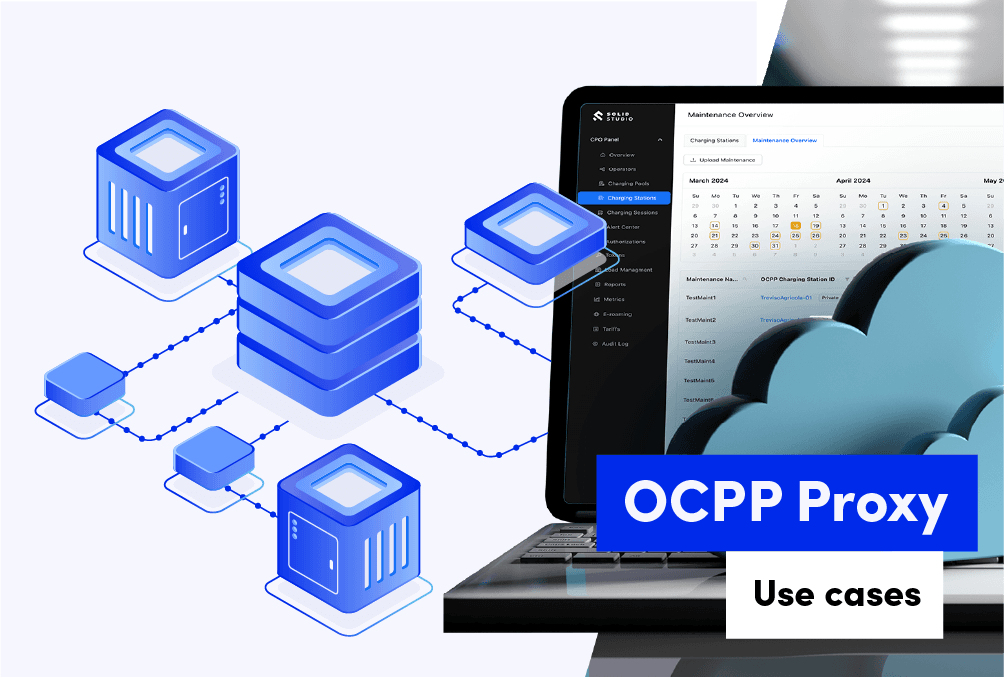If you’ve ever worked with OCPP, you already know the promise: open standards, vendor independence, seamless interoperability.
But here’s the catch: in real-world EV charging networks, things rarely stay that simple.
As soon as you start mixing charger brands, backend systems, and testing environments, one small change can ripple through the whole setup. Want to switch a backend? You’ll need to reconfigure every charger. Want to test a new platform in parallel? Good luck without creating chaos.
In most networks, each charger is still manually tied to a single backend. That static setup means every small change, like switching systems to test new platforms, becomes a full reconfiguration exercise. The flexibility promised by OCPP gets lost in the process.
This is exactly where a smarter approach comes in: decoupling chargers from backends using a lightweight OCPP Proxy layer.
It doesn’t reinvent OCPP, but it adds the missing piece that makes interoperability actually work at scale.
Why traditional OCPP setups fall short
On paper, OCPP is supposed to make your life easier. In practice, it can feel like you’re wiring a house with spaghetti.
Most OCPP networks still rely on a one-to-one connection: each charger knows exactly one backend, and every change means touching configuration at the edge. It works fine when you’re managing a few dozen units. But scale that up to thousands, across sites or vendors, and suddenly you’re juggling:
- Charger reconfigurations for every migration or test
- Downtime during backend transitions
- Compatibility quirks across OCPP versions or vendor stacks
- Vendor lock-in, where flexibility turns into dependency
And let’s not forget visibility. Once a charger connects to a backend, the communication flow becomes a bit of a black box. If something breaks, you’re relying on limited logs or guesswork to find out why.
So even though OCPP gives you a common language, what’s missing is a control layer, in other words, a way to route, observe, and manage that traffic dynamically, without ripping apart your setup every time requirements change.
That’s exactly the gap an OCPP Proxy fills.
Enter the OCPP Proxy pattern
The OCPP Proxy functions as an intermediary layer that manages communication between chargers and backend systems.
It operates transparently between the two, routing and duplicating OCPP messages without modifying their structure or content.
In other words, it doesn’t interfere; it orchestrates.
Technically, it’s a transparent middleware layer that handles JSON-over-WebSocket communication between chargers and one or more backends. But the real value is in the control this architecture provides.
It enables teams to:
- Switch backends dynamically, without reconfiguring chargers or interrupting sessions
- Run multiple backends in parallel for testing, analytics, or multi-tenant setups
- Monitor and debug live OCPP traffic without touching production systems
- Stay compliant with OCPP 1.6 and 2.0.1 across vendors
- Deploy efficiently, whether on-premise, in the cloud, or in hybrid environments
You can think of it as a lightweight, scalable, and fully transparent OCPP broker. The Proxy doesn’t alter messages; it simply manages where they go and how they flow.
Here’s a practical example:
A utility operating thousands of chargers wants to test a new backend while keeping the old one live. Traditionally, that means reconfiguring every charger or running two isolated networks. With the OCPP Proxy, engineers can define new routing rules, and the switch happens in real time. Some chargers connect to Backend A, others to Backend B. No downtime, no disruption.
It’s the kind of flexibility OCPP was designed for, but rarely achieved in production.
The result is a more flexible and future-proof architecture, one that gives operators full control over OCPP communication without touching the chargers themselves. But the real impact of this pattern becomes clear when you look at how different organizations use it.
The OCPP Proxy has become a practical enabler of interoperability across the EV charging landscape, including utilities running multi-vendor networks, integrators building complex infrastructure projects, or backend migration projects, avoiding unnecessary downtime
How the OCPP Proxy fits into real-world operations
The OCPP Proxy isn’t tied to one business model or network size. Its role is to make complex OCPP communication manageable, regardless of how your charging ecosystem is built. Here’s how different types of organizations are already using it in practice.
Backend migration without downtime
Many operators eventually face the same challenge: moving from one backend system to another. Whether it’s due to scaling, vendor changes, or platform consolidation, backend migrations have a reputation for being slow, risky, and disruptive.
In a traditional OCPP setup, migrating means reconfiguring every charger, scheduling downtime, and hoping no connection breaks in the process. The OCPP Proxy makes that process far more controlled.
Decoupling chargers from the backend allows live backend switching through dynamic routing. Operators can direct a subset of chargers to the new system, keep the old one running in parallel, and observe message flows before committing fully. Once validated, the transition can happen without interrupting service or touching a single charger configuration.
For many organizations, this becomes the first real proof point of what a decoupled OCPP architecture can do: deliver operational flexibility without sacrificing uptime.
Utilities and energy providers
For utilities expanding into EV charging, interoperability is everything. Their networks combine chargers from multiple OEMs, often managed across different backend platforms. The OCPP Proxy allows them to switch, segment, or duplicate traffic between those platforms in real-time without touching the chargers.
During backend transitions, the proxy lets teams operate new and legacy systems in parallel, verify message flows, and cut over when ready. The result is a flexible architecture where utilities retain ownership of their infrastructure and data, independent of backend vendors.
Turnkey charging solution providers
Turnkey providers deliver end-to-end charging services such as equipment, installation, software integration, and operations. What slows them down is the integration complexity: every client has unique hardware and backend preferences.
With the OCPP broker in place, these providers can unify communication between diverse charger models and backend systems, supporting multi-tenant or client-specific setups.
It turns custom integration work into configuration, shortening deployment timelines, reducing maintenance, and allowing fast iteration across projects.
Technology and mobility service providers
Fleet management, telematics, and energy optimization platforms increasingly include EV charging as part of a broader offering. But integrating chargers into those digital ecosystems usually means rewriting parts of the backend or building custom connectors.
The OCPP Proxy eliminates that friction. It routes and replicates OCPP traffic between chargers and internal systems, enabling data sharing and analytics without backend rewrites.
This approach keeps platforms modular, scalable, and backend-agnostic, ideal for fast-growing technology environments.
Engineering and industrial integrators
For system integrators working on industrial sites, transport infrastructure, or citywide charging projects, reliability and transparency matter more than anything.
They need visibility into OCPP traffic during deployment and commissioning, and they often deal with layered or distributed networks.
The proxy provides a controlled communication layer, allowing engineers to manage routing, inspect message flows, and debug in real-time. It replaces ad-hoc middleware with a proven, production-ready component that reduces development risk and improves stability at scale.
Fleet and depot operators
Operators managing multiple depots or regional networks face another challenge: maintaining stable connections across mixed hardware and backend systems.
With the Proxy, they can segment traffic by region, manage backend transitions without downtime, and centralize monitoring across the entire network.
It ensures consistent operation and visibility even as the fleet grows and infrastructure evolves.
Architecture overview
OCPP Proxy is designed to stay out of the way. It doesn’t replace your backend or change the OCPP protocol. It simply manages how communication flows between chargers and central systems, transparently and in real time.
The architecture follows a lightweight, scalable model built around a few key principles:
- Transparency:
The proxy passes OCPP messages exactly as they are, maintaining full protocol compliance. Both the charger and the backend remain unaware that a proxy is sitting in between. - Dynamic routing:
Routing rules define where traffic goes: per charger, per backend, or per message type. Those rules can be adjusted at runtime, without restarting the OCPP broker or reconfiguring hardware. - Scalability:
Each instance can handle thousands of concurrent WebSocket connections with minimal resource overhead. The proxy runs as a containerized service and scales horizontally using standard load balancers or orchestration tools. - Deployment flexibility:
It runs anywhere Docker does, be it cloud, on-premise, or hybrid. This makes it simple to integrate with existing CI/CD pipelines or infrastructure setups. - Persistence and stability:
Routing rules and connection states are stored in a lightweight, persistent layer so that configurations survive restarts or redeployments.
In short, the OCPP Proxy adds control without adding complexity. It’s a modular building block that can sit neatly inside almost any EV charging architecture giving engineers the flexibility to manage, migrate, or monitor at scale.
Getting control without the chaos
At the end of the day, managing EV charging infrastructure shouldn’t feel like juggling cables in the dark. If switching backends, adding systems, or troubleshooting OCPP traffic still feels complicated, that’s a sign your architecture is doing too much heavy lifting on its own.
A simple routing layer, like the OCPP Proxy, can take that complexity off your plate. It gives your team control without chaos, visibility without risk, and the freedom to evolve your setup at your own pace.
If you’re ready to make your OCPP environment a little smarter and a lot easier to manage, let’s talk about where this fits in your network.

